Anyone can create a website nowadays. However, it takes specialized knowledge to create a website that generates sales. First and foremost, your target customers should be able to find your site online via search engines like Google.
After finding your site, they must trust you before they buy anything from you. Your website must have all the elements that make a web page trustworthy as well as have functional elements that facilitate online transactions. All these fall under e-Commerce website design, so let’s analyze these elements and requirements in depth to make sure your eCommerce site is as solid as possible
Why is eCommerce website design important?
- The global eCommerce market is a $4 trillion + market as of 2022 and it is expected to grow tenfold to $58 trillion by 2028.
- It’s clear the world is quickly departing from offline retail purchases.
- Shoppers are increasingly preferring eCommerce convenience as opposed to flocking to physical stores.
- The first touchpoint between many customers and businesses today happens online.
- The growth of social media and reliance on Google to find information online has made it critical for businesses to establish a good online presence, which is as important today, if not more, than renting physical store space.
Creating an eCommerce website is the best way to take charge of your online presence, which is why we can’t emphasize enough the importance of ensuring your eCommerce website is not only functional but also successful.
If you want a website that people will visit and be willing to buy what you are selling then it’s absolutely critical that you take the time to understand the key elements of eCommerce website design, which is exactly what we’ll be covering in this guide.
What is an eCommerce website?
Let’s start at the beginning. An eCommerce website is simply a website that facilitates eCommerce (buying/selling online). ECommerce website design refers to the process of designing that website while taking into account all the features that are specific to eCommerce, the aspects that are made with this particular industry in mind.
What goes into designing an eCommerce website?
The main goal when designing any eCommerce website should be creating a seamless online shopping experience. For this to happen, you must create a site that adds value and makes it easy for site visitors to transact. Such a site must be functional, have a revenue model, and offer a competitive advantage, additionally, it needs a marketing strategy. These are broad factors of what it means to design a successful eCommerce website, let’s get into the specifics of what the building and design process of an eCommerce website actually entails.
How to build an eCommerce website from scratch
If you are looking to build an eCommerce website from scratch, here’s a step-by-step guide you can follow.
Step 1: Choose an eCommerce platform
You can use eCommerce website builders like WordPress, WooCommerce, and Shopify to create sites from scratch as a beginner with no programming experience.
Different platforms will offer different pros. Most platforms can be differentiated by features and pricing. It helps to look at the pros and cons of each platform individually before choosing one. You can then proceed by creating an account with your preferred platform and registering a website domain or migrating an existing one. ECommerce platforms have domain and hosting plans you can select based on your preferences.
Step 2: Select a suitable theme or template
Website builders have pre-made themes or templates that show you how your website will look and feel. Different eCommerce platforms have different themes to choose from. Most importantly, you can choose free themes or paid themes (if you want a unique site).
While you can select any theme you like based on your own personal preferences, a great eCommerce theme/template should consider the audience and the desired feel. For instance, there are themes that will look more professional than others and this difference could become crucial depending on the type of eCommerce website you wish to build, the products you will be selling and your branding strategy.
Step 3: Customise the website template
Once you have a preferred template, you’ll need to customize it to match your website design goals. Customization will generally involve adding content, configuring site navigation, building website pages, creating product listings or service listings, etc. Depending on the website builder you are using this process might not always require previous coding knowledge, but that doesn’t necessarily mean it will be easy.
Adding different elements to a site and building all the necessary pages can be overwhelming and time-consuming. If you don’t already know how to customize a WordPress site, WooCommerce site, Shopify site, or sites built using other website builders, we recommend you consider hiring a website design company that specializes in eCommerce sites. Such companies can take care of the building process as well as the design and customization.
Step 4: Setting up a payment gateway
Before your eCommerce website can receive and process orders, you must set up a payment processor. There are many payment methods today. However, most eCommerce business owners choose third-party tools like PayPal and credit cards that make payment processing easy and more secure.
If you are considering payment integrations that don’t involve popular third parties like PayPal, assess the security of the payment integration tool in question. You should also consider the ease of integration with your eCommerce platform, the tool’s PCI (payment card industry) compliance, and the fees you/your customers will pay to use the tools. As you can see, the best payment options for you will depend on several considerations so make sure you analyze them all before making your final decision.
When setting up a payment gateway, it’s also advisable to think about other integrations like shipping and sales tax. Shipping is a critical part of every eCommerce website. You need a shipping policy (free shipping, flat rate shipping, or variable fee shipping). This should also be accompanied by a return and refund policy.
ECommerce sites also need to consider applicable tax and other fees during checkout. Adding this automatically will call for a seamless shopping/sales experience that doesn’t have hidden fees.
Step 5: eCommerce site testing and launching
The last step of building an eCommerce website is testing. You must test all the features and functionality of a website before launching. Website testing is a rigorous process that involves every element of a site, including buttons, links, emails, etc. By the end of the process, the site should look great, work perfectly on any device, and process payments without a hitch.
Most sites have a beta testing phase open to anyone, including the public, in which everything is tested. A typical testing phase should ensure different emails are sent to the right place before, during, and after purchases. The site should also be tested with different browsers and devices. Additionally, website content should be optimized for search engines (SEO) and be free of errors.
Site testing should be followed by a website launch. Having a perfectly designed website won’t mean much if you don’t make a deliberate effort to “create a buzz”. Website launches can take many forms, including well-calculated marketing campaigns. You’ll need to set up social media pages, create guest posts and press releases (depending on your niche), launch social media campaigns, etc. If you have a budget, you can use paid Google ads or social media ads.
So far we have covered what it takes to build an eCommerce website, now, let’s see the specific eCommerce design aspects that can boost your newly built site. There are several design elements you can consider.
Website design elements
There are some eCommerce website design elements that are more important than others.
These elements will determine if visitors can properly find your site, understand how it works and decide to purchase what you are offering. The most relevant factor we’ll discuss include homepage design, UX design, and SEO.
1. eCommerce homepage design
The homepage is the main page of any website. In an eCommerce site, the homepage design determines the bounce rate to a large extent. Ideally, most visitors will land on your homepage and then visit other pages (product/service pages).
Bounce rate is a measure of the percentage of people who enter and leave your site without visiting any other pages. If your homepage design is “off”, site visitors will leave within seconds of landing on your homepage. So how should you design a homepage?
Key aspects that are a must for an eCommerce homepage
a. Simplicity: We believe simple designs offer better user attention and engagement than complicated ones. Since the homepage is the first page users interact with, it needs to be simple. However, simplicity shouldn’t be mistaken for boring. The goal of a simplistic homepage design is to ensure users don’t get confused about what step to take. They should be able to find things like navigation, menus, search bar, shopping carts, and other crucial eCommerce homepage components with ease.
Let’s take a look at an example:

Swimoutlet’s homepage is a perfect example of simplicity. You know exactly what to do as a first-time or repeat website visitor i.e., sign up, login, or start browsing for different product categories. The homepage also has menus at the bottom that let you visit many different pages and discover information on shipping, returns, clearance sales, about the company, and more.
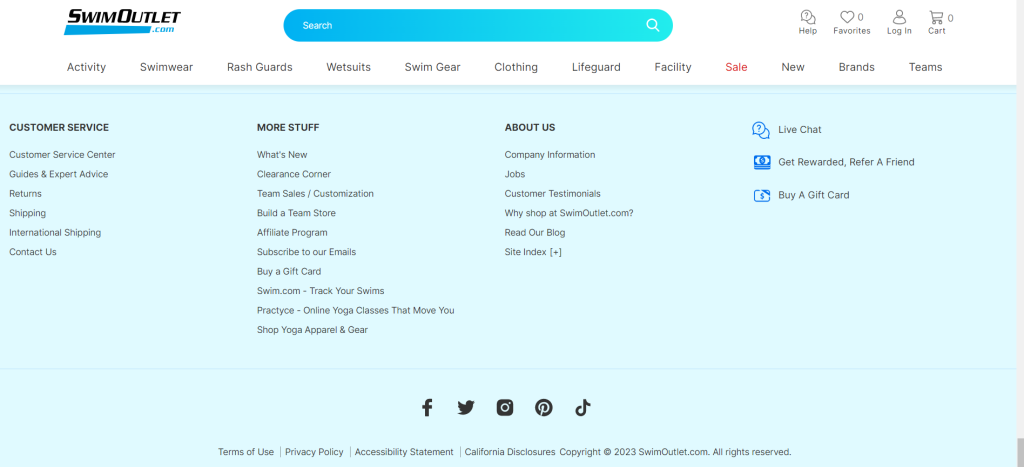
b. Ideal color: There is no denying that color influences our physiological responses. Different color palettes trigger different emotional reactions and influence behaviors. For instance, a blue room can induce calmness or feelings of stability and safety.
Swimoutlet’s choice of a blue and white background theme on the homepage is ideal given they are a swimwear brand that customers should find safe and comfortable. Most importantly, blue resonates with water, making it a great color for a swimwear brand.
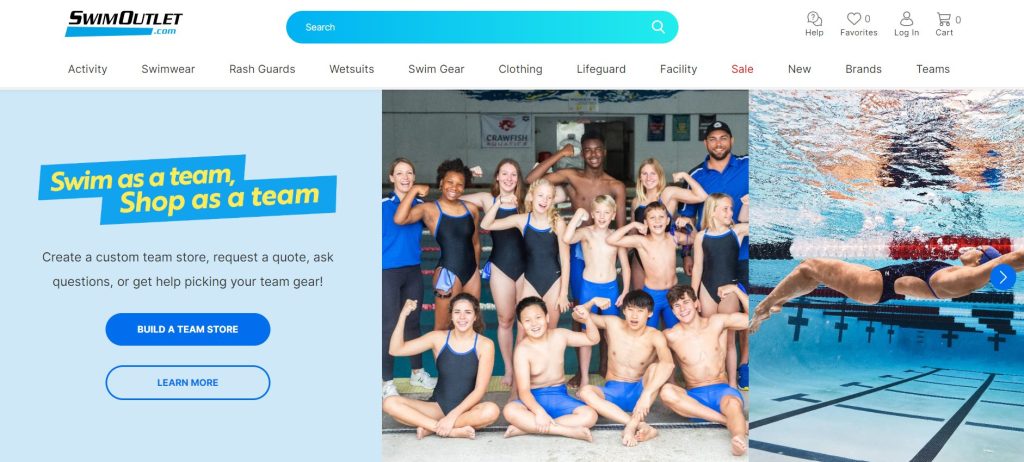
c. Trust factors: Every eCommerce website homepage needs trust factors. If you have products/services from popular brands, show them on your homepage. Showcasing logos of brands affiliated with your business is also a great addition to your homepage design as it helps to place you as an industry leader and create trust.
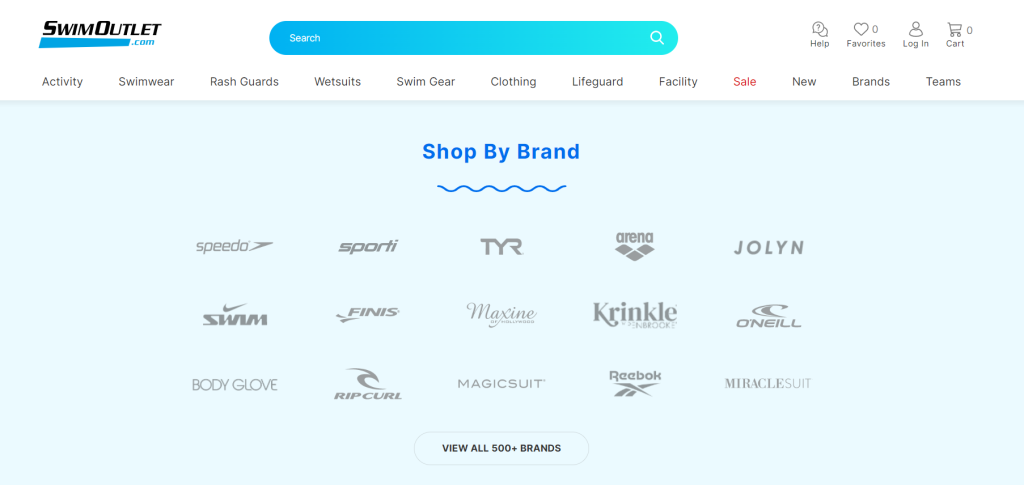
Customer testimonials are also important trust factors. Since all eCommerce site visitors look for social proof before purchasing from a website, having testimonials on your homepage makes it easy for potential customers to find social proof.
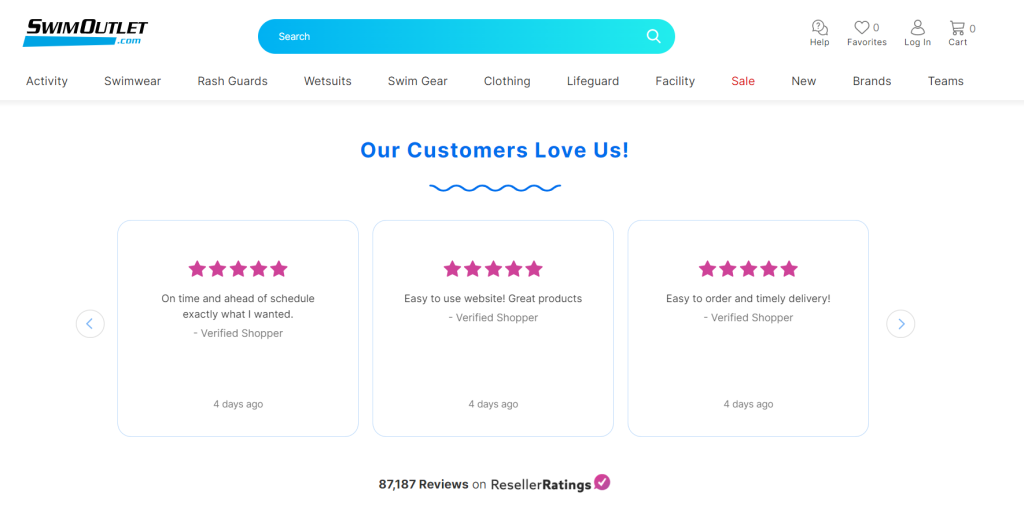
d. Business info: An eCommerce website homepage also needs to have all the necessary business information such as company information, contact information, shipping policy, refund policy, etc.

Most importantly, when providing company information it’s key that you include the physical location of your business to boost trust, if you have one. Having an online business that also has a physical location can be practical for certain users and serve as a reassuring security measure. If you don’t have a physical location then make sure your other trust factors are in place to aid potential customers feel at ease when purchasing from your site.
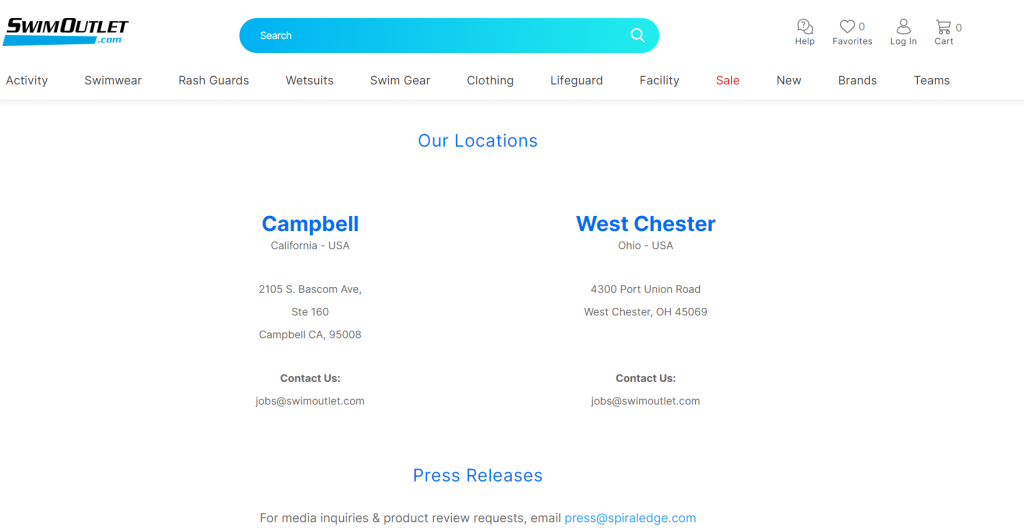
e. Featured products/services: The homepage also needs some featured products/services. These should be the most popular products/services or best deals, presented through eye-catching illustrations or design elements, i.e., discounts. However, this shouldn’t be mistaken to mean that the homepage should be transformed into a product listing page. Swimoutlet, for example, has featured products perfectly.
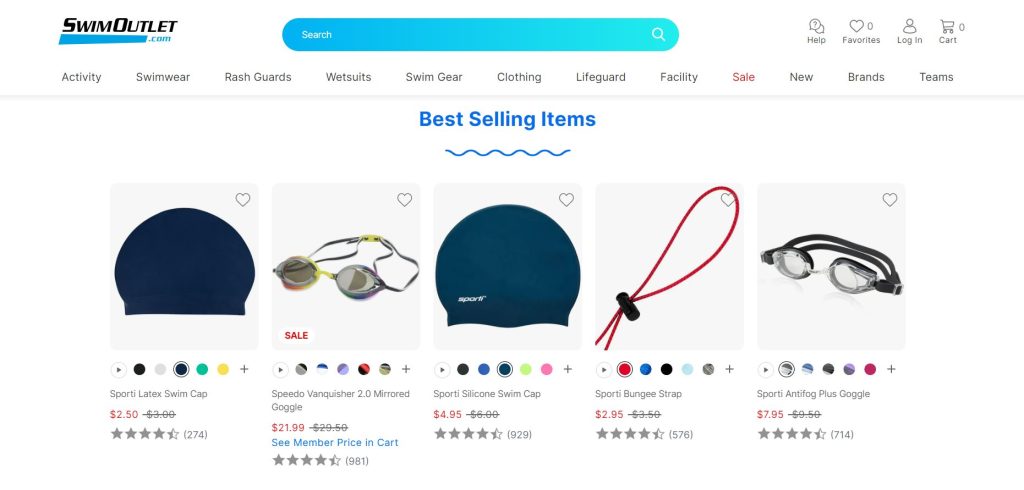
f. Clear CTA (call-to-action): Lastly, an eCommerce homepage needs a clear CTA (call-to-action). You should prompt your potential customers to take favourable action, such as creating an account on your website, becoming a member, adding items to the shopping cart, and later on making the final purchase, etc.
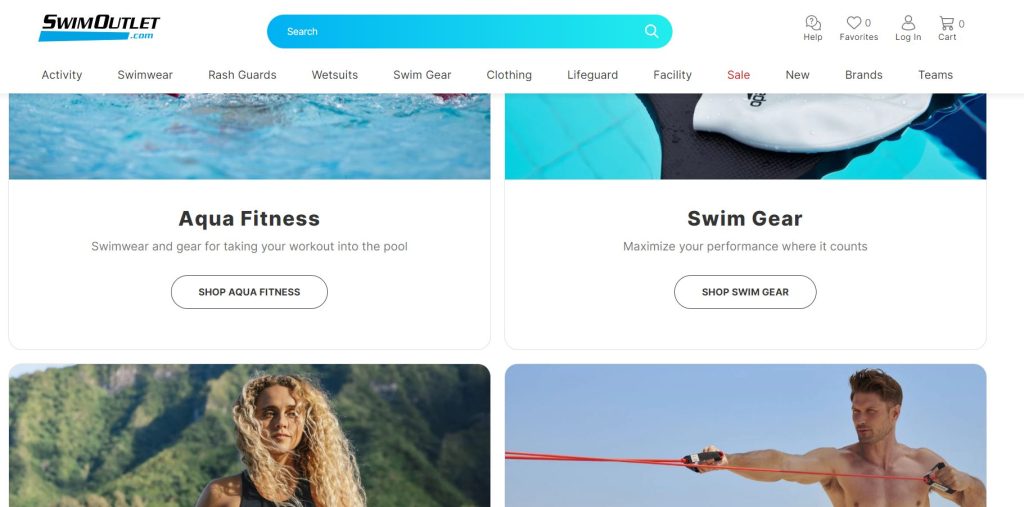
There may be other aspects to consider with an eCommerce homepage, however, the above key aspects are enough to give you a competitive advantage provided they are implemented correctly.
2. eCommerce UX design
Besides homepage design, another critical eCommerce website design element is UX (or userexperience). Ensuring your eCommerce website is accessible to any potential customers and through any device they might be using will be a decisive factor in your business’s success.
In a nutshell: UX is about making sure your website isn’t distorted regardless of the device your site visitors are using. From our previous example, swimoutlet.com looks great on PC. As shown below, the website also looks great when accessed using a smartphone (iPhone) and tablet (iPad).
Swimoutlet.com accessed on an iPhone

Swimoutlet.com accessed on an iPad

Should you build an eCommerce mobile website?
Building a separate eCommerce mobile website is not always necessary. To make the right choice for your business, make sure you consider UX design from the start, create a website that adjusts automatically and looks great on any device, including mobile devices, and that way you will not require any additional mobile apps.
Incorporating UX design into an eCommerce website
There are many UX design elements to consider to ensure you build a user-friendly website. The most notable include confirming your site can be easily navigated. The site also needs to be fast (loads in 1 or 2 seconds), have a site search function, and have a simple checkout process. The high-quality photos and videos (if any) also need to be optimized in a way that they don’t slow the site down and appear correctly on all devices.
If you are using an eCommerce website builder like WordPress, there are inbuilt UX features that make UX design easier. Here’s the UX design feature for WordPress (elementor WordPress plugin) showing how the site looks on different devices.

3. eCommerce website SEO strategy
Another crucial eCommerce website design element is a solid SEO strategy. Every new e-Commerce site needs content and, most importantly, that content should be carefully created to guarantee the website ranks high on search engines like Google.
A concrete SEO strategy is critical for knowing what type of content to create for your website. It should cover every aspect of content, from keyword research to the actual content creation, keyword optimization, creating meta descriptions, adding title tags and keywords to product photos, and other types of content.
Since there’s a lot that goes into a solid SEO strategy, different eCommerce stores will have different SEO needs. Not every SEO aspect might be entirely relevant for every eCommerce store and the process of optimizing a website can be highly technical, for this reason, we think it’s advisable to hire professional services that can guarantee a customized SEO strategy that will meet your particular business’s needs.
However, if you would like an overview of the process, these are the aspects we think should be involved in an eCommerce SEO strategy:
I. Off-page SEO for an eCommerce website
This includes all factors outside a website that have an impact on search ranking. Typical examples would be social media presence/mentions, and backlinks (links to your e-Commerce site that originate from other websites).
II. On-page SEO for an eCommerce website
On-page SEO is about all factors within a website that impact SEO. This includes keywords, site speed, UX, content, image optimization, meta descriptions, title tags, etc.
III. Local SEO: Target audience for eCommerce website
Local SEO is critical for targeting audiences in specific local jurisdictions, such as a city or town. If your eCommerce website is targeting people in Toronto or Palm Beach, Florida, your eCommerce SEO strategy should reflect the location during keyword optimization, which means searching for location-specific keywords that relate to your business and using the prioritized keywords on phrases, headings, and other internal sections along your content.
IV. eCommerce site speed
As mentioned, site speed is a critical factor in SEO. Google has site speed tools meant to help eCommerce business owners assess and optimize site speeds. A slow site won’t rank very well even if all other factors are perfect.
If you test your eCommerce site and discover it loads in more than 2 seconds, you can try to compress all high-quality images in the site to boost site speed. Other remedies that improve the speed of an eCommerce site include reducing redirects, enabling browser caching, and changing the hosting. Some remedies may be too technical. If you try the above and don’t improve your site speed significantly, consult an eCommerce website design expert.
V. eCommerce site audit
An eCommerce website SEO strategy must include a site audit to determine if your SEO efforts are working. An eCommerce audit will also uncover the aspects of SEO and website design that need to be improved or changed. A simple audit can be done by reviewing the content of your website to make sure it is optimized to meet search engine’s standards, that all the links and backlinks are working, the location pages are in place (if it’s relevant), and that your overall efforts are having the desired effect. For a more thorough audit, you should consider hiring professional help.
eCommerce website examples
Besides swimoutlet.com, there are several other eCommerce websites that are worth mentioning as good examples of what to do while creating your site. Specifically when it comes to having a good UX design, clear CTAs, and a well-curated homepage (that is simple but has important elements like trust factors, the ideal color, important business information, and featured products/services).
1. Hats.com
This website has a great homepage with all the elements discussed above, like a the featured products, clear CTA, and trust factors (renowned brands)



2. Toysrus.com
Toysrus.com is another example of a well-designed eCommerce website. This site looks great on desktop PC and mobile devices.


It also has implemented homepage trust factors and CTAs.
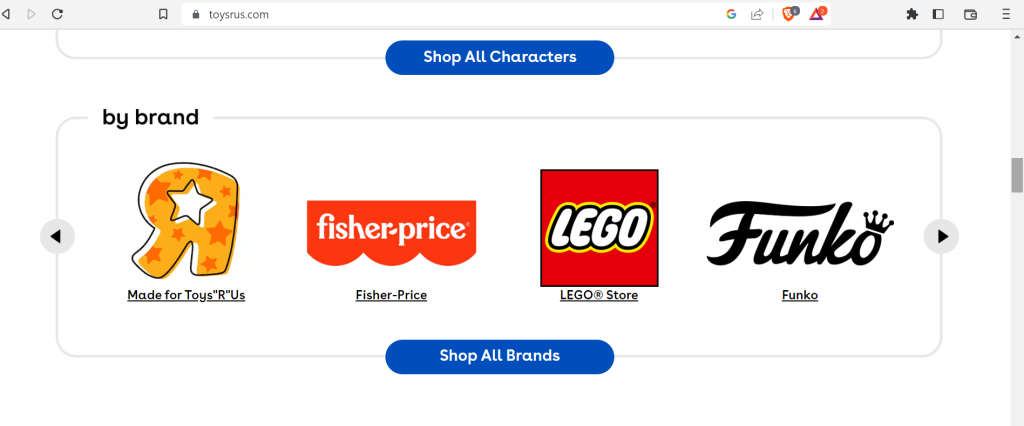
To wrap it all up…
A well-designed eCommerce site is a must if you wish to attract website visitors, build trust and generate sales consistently. As mentioned above, a good eCommerce website needs a superior homepage that is simple but has important elements like trust factors, the ideal theme color, important business information, featured products/services, and a clear CTA. UX design and a concrete SEO strategy are also crucial ingredients of successful eCommerce website design.
To get the website design aspects right, you need to dedicate your time to learning how to design eCommerce websites. You can design your own eCommerce site using website builders, but you need time and expert knowledge to build a site that stands out.
We happen to offer professional help to those in need of expert eCommerce web developers or expert eCommerce website design services. We are eCommerce web designers with decades of combined experience. Find out more about our eCommerce website design services and our comprehensive digital marketing services by booking a FREE 30-minute strategy session, in which we can discuss your eCommerce needs, what should be the best course of action to make sure your business stands out, what type of pages are required, and much more.
FAQs
Can you create an eCommerce website for free?
Yes. It’s possible to use website builders like WordPress and create a free site. However, a free website comes with many limitations. For instance, you won’t be able to get a custom domain or have access to many great website templates. Free websites also have limits on space, security features like SSL certificates, and other key elements that make a website secure and unique.
Can I create an eCommerce website on my own?
Yes! Website builders like WordPress can be used by people with no previous coding experience, but we must warn you: the end result might not be as professional-looking as you’d like and the process can be long. However, if you have the necessary time to learn the building process and find the design elements that will help your business stand out then you should absolutely give it a try. If, on the other hand, you realize it takes more than you were expecting, then hiring professional help might be the best solution fro you.
Which website builder is best for eCommerce?
It depends. Website builders like WordPress can perform better or worse than other builders like Shopify depending on underlying factors. For instance, WordPress is more cost-effective than Shopify. WordPress also has an advantage based on scale and proven capacity. There are over 800 million WordPress sites today (as of 2023) vs 4 million Shopify sites. Shopify, on the other hand, may be best suited for Amazon-like sites than WordPress.
What is the best eCommerce site for beginners?
It depends. As mentioned, different sites will be greater than others for different reasons. However, Shopify is generally preferred by beginners who wish to set up Amazon-like stores quickly. WordPress is great for beginners keen on a cheap, user-friendly, and SEO-friendly website builder.
How often should website content be updated?
It’s recommendable to update the website content or post new content as often as possible. For the best SEO results, website content should be updated weekly. However, if you are posting long-form content, monthly updates will also work for SEO purposes. Keep in mind, updates aren’t enough if the content doesn’t offer significant value, which is why having a solid SEO strategy will make a huge impact on your content.
How often should a website be redesigned?
Generally, the site design should be updated after one to three years. However, the process can be more frequent if there are major site issues revealed after a website audit.





